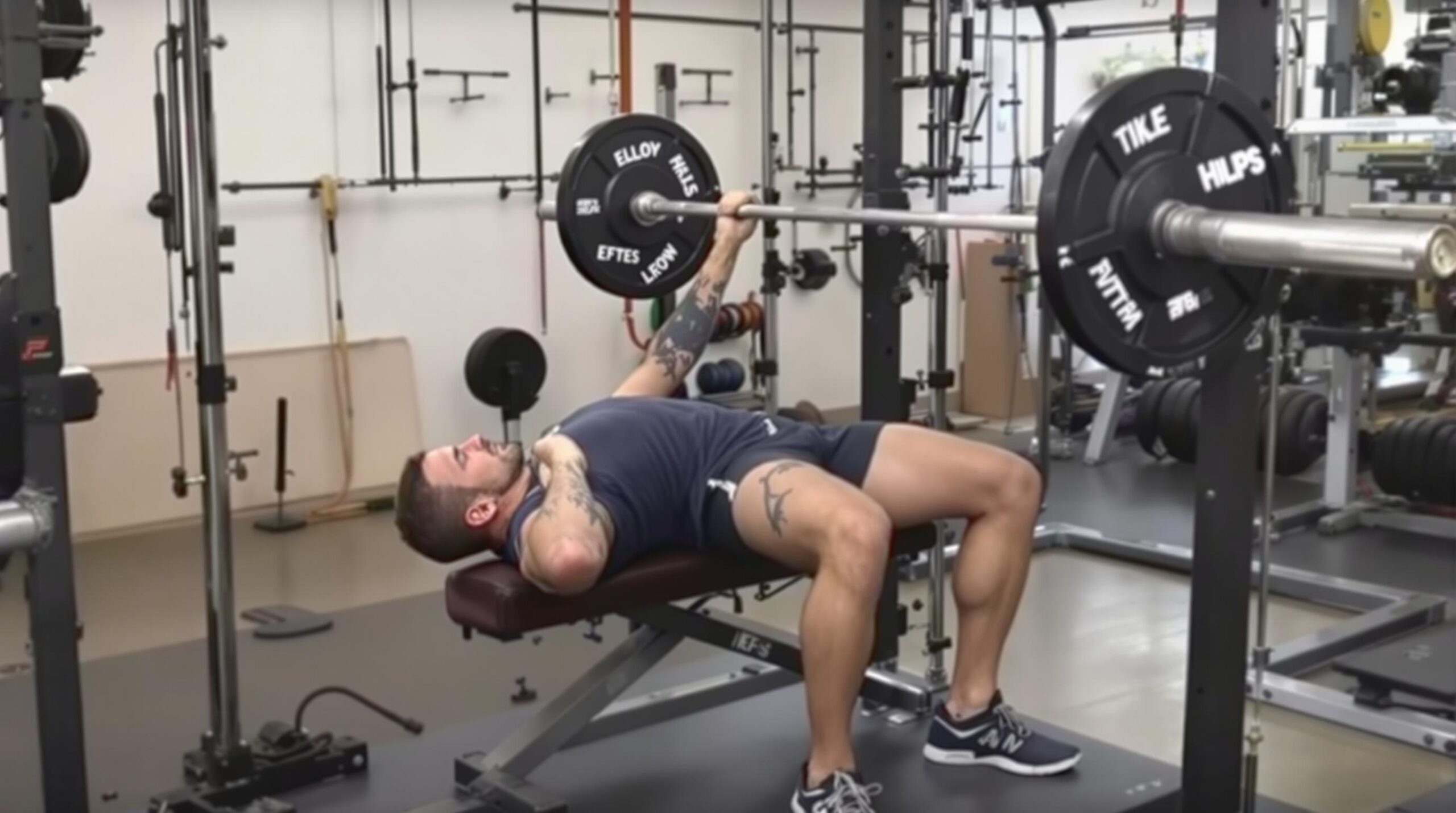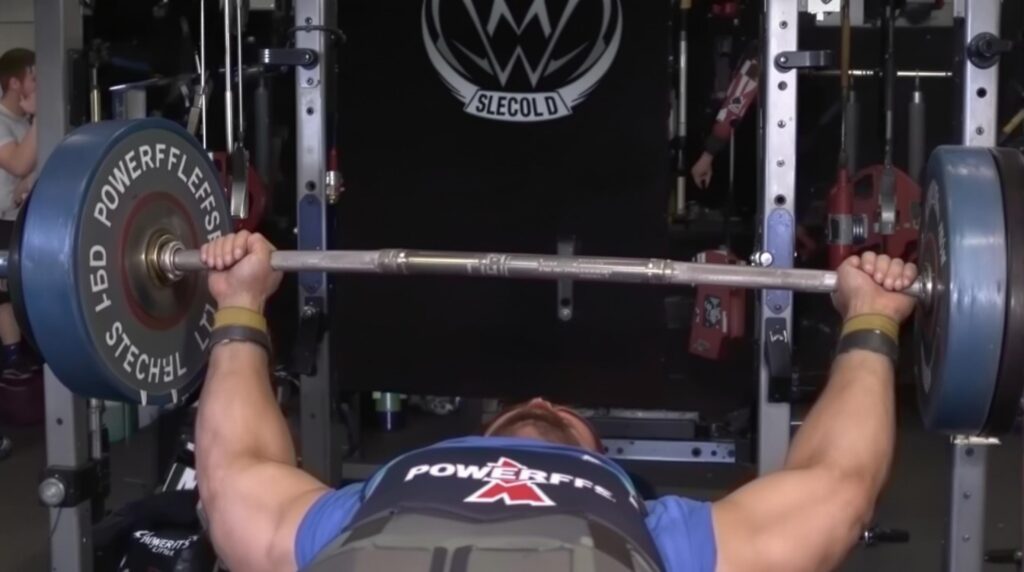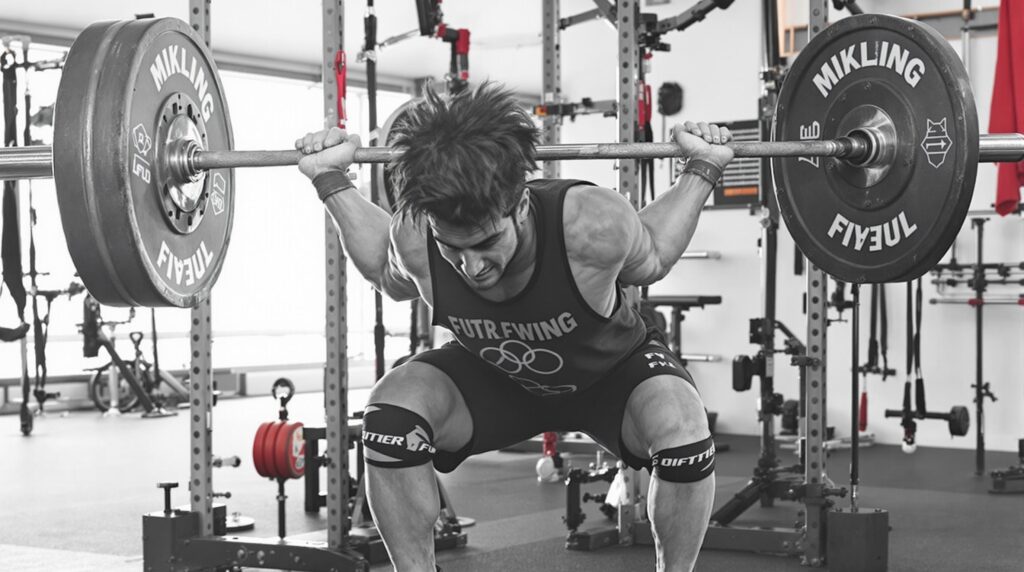The debate over elbow position during bench press is a crucial consideration for strength athletes and fitness enthusiasts alike. Proper elbow positioning not only impacts muscle activation and strength development but also plays a significant role in preventing injuries that could sideline your training progress for weeks or months.
Key Takeaways
- Flared elbows (45-60° from torso) increase pectoral activation by 20-25% but raise shoulder injury risk
- Tucked elbows (30-45°) boost triceps involvement by 15-20% while reducing shoulder stress
- A moderate 45° angle provides the optimal balance between muscle activation and joint safety
- Training to failure increases elbow joint forces by 18% and raises injury risk
- Your ideal elbow position should be based on individual anatomy and goals
The Biomechanics Behind Elbow Position
The angle of your elbows during bench press fundamentally changes how force travels through your upper body. When your elbows flared beyond 60°, you’ll notice a shorter range of motion by 10-15%, but this comes with a concerning 25% increase in shoulder joint torque compared to a more moderate 45° angle. On the flip side, tucking elbows close to 30° extends the bar path but significantly reduces shoulder external rotation, which helps minimize impingement risk.
Scapular movement also varies dramatically with elbow position. Flared positions require 30-40° of scapular upward rotation to maintain stability, while tucked positions keep scapular movement to a minimum. The danger zone appears when over-tucking forces excessive forearm pronation, which can increase lateral elbow force by 12% during the pressing phase.
Recent biomechanical research from 2025 shows that a 45° elbow angle reduced peak elbow joint force by 17% compared to extreme positions in either direction. This middle ground represents the sweet spot for most lifters, balancing performance with joint health.

Muscle Activation: What Your Elbow Position Targets
Your elbow position significantly determines which muscles bear the brunt of the work during bench press. With elbows flared to 45-60°, you’ll experience pectoralis major activation increasing by 20-25% compared to tucked positions, particularly in the sternal (lower chest) fibers. This explains why bodybuilders often prefer a wider, more flared position when chasing chest development.
Tucking your elbows closer to your body shifts emphasis to the triceps, boosting their involvement by 15-20%. This triceps-dominant pattern can enable heavier loads for some lifters due to improved leverages. However, the anterior deltoid experiences about 30% higher activation in flared positions, which may elevate injury risk during high-volume training phases.
EMG data reveals that a moderate 45° angle strikes an impressive balance, achieving about 65% of maximum voluntary contraction (MVC) in the pectorals and 55% MVC in the triceps, while keeping deltoid strain more manageable. Your grip width further amplifies these effects – narrow grips with tucked elbows maximize triceps recruitment, while wider grips with flared elbows create optimal pectoral stretch and activation.
Injury Risks: Understanding the Dangers
Improper elbow positioning can lead to significant injury concerns that might hamper your long-term strength progress. When elbows are excessively flared, subacromial space compression increases by about 35%, dramatically raising impingement risk during the descent phase. This explains why shoulder pain is common among lifters who consistently bench with severely flared elbows.
Conversely, overly tucked elbows correlate with a 22% higher incidence of medial epicondylitis (golfer’s elbow) due to repetitive forearm pronation. Training to failure compounds these risks, increasing medial-lateral elbow force by 18% and internal-external joint moment by 15% as form breaks down.
A 2024 clinical review linked flared techniques to 58% of bench-related shoulder injuries, while tucked positions accounted for 34% of elbow tendinopathy cases. Fatigue effects significantly compound injury risk as technique deteriorates through high-volume workouts, making proper position even more crucial during longer sessions.
Finding Your Optimal Elbow Position
For most lifters, a 45° elbow angle represents the ideal compromise, balancing pectoral activation (60% MVC) with triceps involvement (50% MVC) while minimizing joint stress. Medium grip widths measuring about 1.2 times your shoulder width help align the forearm vertically, reducing elbow valgus torque by 20% compared to narrower grips.
A slight J-curve bar path with elbows transitioning from 45° to 60° during the ascent phase improves force transfer. Many elite coaches recommend the “flare and push” cue, where you start at 45° before gradually flaring to 55° to effectively engage the pecs during the pressing motion.
Individual anatomy plays a crucial role in determining your ideal position. Lifters with shoulder instability benefit from a 30-40° tuck, which reduces scapular upward rotation demands by 25%. Those with longer arms might need slightly more flare to maintain efficient bar path, while those with a history of elbow issues should favor a more moderate position.
Training Applications Based on Your Goals
Your training objectives should guide your elbow position strategy. Here’s how to adjust based on specific goals:
- Novice lifters should start with a 45° elbow angle and medium grip to build balanced strength development
- Hypertrophy focus calls for flared elbows (55-60°) with 70-75% 1RM for 8-12 reps to maximize pectoral growth
- Strength athletes benefit from a slight tuck (40°) and closer grip with 85-90% 1RM for 3-5 reps
- Injury-prone lifters should adopt a 30-40° tuck and limit training volume to 5 sets or fewer per week
Competitive powerlifter Jennifer Thompson exemplifies flared elbow efficiency, bench pressing 2.4 times her bodyweight using a 55° angle. Her technique demonstrates how proper elbow positioning can maximize performance while maintaining joint health through hundreds of heavy training sessions.
Prevention Strategies to Protect Your Joints
Implementing proper joint protection strategies will extend your benching longevity. Limit elbow flaring to 60° or less during heavy sets to reduce shoulder stress. Avoid excessively wide grips (beyond 1.5x shoulder width) to minimize unwanted scapular protraction that can lead to positional weaknesses.
Consider incorporating these prevention techniques into your training:
- Use tempo variations with 3-second eccentric phases to improve joint stability under load
- Alternate between dumbbell bench presses (which create 15% less elbow stress) and floor presses
- Implement proper warm-up protocols targeting rotator cuff and scapular stabilizers before heavy pressing
- Periodize your training to include deload weeks that reduce joint fatigue by 30%
- Consider supplementary exercises to strengthen the muscles that support optimal elbow positioning
Adding lower chest cable flies as an accessory movement can help build balanced chest development while taking pressure off the elbow and shoulder joints that heavy benching might aggravate.
Finding Your Personal Sweet Spot
Individual factors like anatomy, injury history, and goals should guide your elbow position selection. What works for a competitive powerlifter won’t necessarily be ideal for someone focused on bodybuilding or general fitness. Self-assessment is critical for determining your optimal position based on comfort and strength.
Try filming yourself from the side during bench press sessions to analyze your current elbow angle. Experiment with slight adjustments of 5-10° in either direction, tracking both performance and how your joints feel during and after training. Gradually shift your elbow position without sacrificing performance, giving your body 2-3 weeks to adapt to each adjustment.
Progressive loading strategies that respect joint limitations are essential. Start with lighter weights when changing your technique, then gradually increase intensity as movement patterns become ingrained. Consider hybrid approaches that vary elbow position based on training phase and intensity—perhaps using more flare during moderate-weight hypertrophy phases and more tuck during heavy strength-focused sessions.
Remember that optimal technique is highly individual. What feels most powerful while keeping your joints pain-free is likely your best position, regardless of what works for others.
Sources
strongerbyscience.com – Why You Should Not Tuck Your Elbows Benching
gymplanapp.com – Bench Press Elbows In or Out
muscleandstrength.com – Expert Guides Bench Press Mistakes
temple-of-iron.com – Bench Press Tuck or Flare
pmc.ncbi.nlm.nih.gov – PMC4080597



